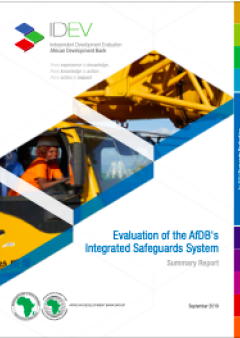
Member's Documents
Evaluation of the Bank's Safeguards System
Published by: Independent Development Evaluation, African Development Bank
IDEV’s evaluation of the effectiveness of the Bank’s ISS, presented to the AfDB Board of Directors on 7 October 2019, assesses the relevance and robustness of its design; the efficiency of the system, process, resourcing and incentives in place; and its emerging effectiveness in achieving the Bank's safeguards objectives.
Key findings of the evaluation include:
- The Bank's ISS architecture is on a par with international best practices, with some areas for improvement to better cover relevant emerging safeguards issues.
- The ISS was found to be well-aligned to the Bank's Ten-Year Strategy, and its contribution to corporate objectives, notably ensuring the sustainability of Bank-funded operations, was well articulated.
- In terms of compliance of Bank projects with the ISS, the quality of the Bank’s environmental and social (E&S) safeguards work was found to be strong, but various areas for improvement were identified.
- Although the Bank was generally found to be compliant with its disclosure requirements before Board approval, there were limitations in the use of E&S documents by stakeholders and deficiencies in their archiving.
- To operationalize the Bank's ISS, environmental and social mitigation measures are agreed with borrowers and E&S conditions are included in operations loan agreements. However, the evaluation found that reporting on these E&S covenants and mitigation measures was poor and inconsistent.
- The evaluation found mixed E&S performance for Bank operations through Financial Intermediaries (FI) - such as lines of credit to banks and microfinance institutions, or investments in private equity funds. E&S safeguards performance of FIs was found to be strong at appraisal, but their implementation was difficult to evaluate due to limited information available.
The evaluation made six major recommendations to Bank Management, including:
- Increase the Bank's E&S safeguards resources to better support borrowers and clients to manage E&S impacts and risks across the project cycle.
- Support borrowers and clients to manage E&S impacts and risks across the project cycle and establish systematic cross-support linkages between the teams dealing with E&S safeguards, climate change, and gender.
- Develop an integrated and automated management information systemacross the project cycle and resume the Management-led safeguards compliance reviews/E&S audits.
- Strengthen the content and guidance of certain selected safeguardscomponents to ensure full alignment with international best practice.
- Reinforce the Readiness Review process; ensure compliance with the E&S sub-categorization of FI operations; and standardize the loan covenants regarding E&S reporting for FIs.
- Strengthen safeguards reporting to sharpen the focus on delivery and results.
- Reinforce the knowledge and awareness of internal and external stakeholders on the ISS requirements, by developing additional tailored training on these requirements and launching discussions with other development partners on opportunities to jointly organize capacity building in E&S safeguards performance.
